between authenticity & artifice
alex lazaridis ferguson: push 2012, vancouver
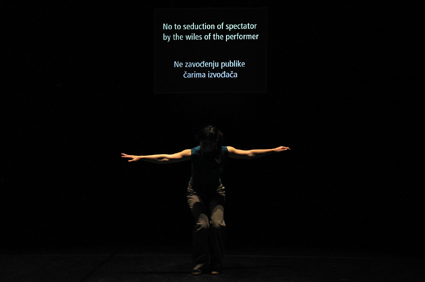
After Trio A, Andrea Božić
SOMETHING REMARKABLE HAPPENED AT THIS YEAR’S PUSH FESTIVAL. FESTIVAL DIRECTOR NORMAN ARMOUR DIED AND CAME BACK TO LIFE. HE SUFFERED A CARDIAC ARREST PART WAY THROUGH A CONCERT BY MARY MARGARET O’HARA AND PEGGY LEE. THANKFULLY, SOMEONE WAS ON HAND TO ADMINISTER CPR AND RESTART THE HEART—TEMPORARILY. ARMOUR’S PULSE AGAIN DISAPPEARED, BUT PARAMEDICS ARRIVED, APPLIED THE DEFIBRILLATOR AND THE PULSE WAS BACK. EN ROUTE TO THE HOSPITAL THE HEART WENT SILENT AGAIN. ONE MORE CHARGE OF ELECTRIC CURRENT TO THE CHEST WALL DID THE TRICK, AND ARMOUR WAS TRULY BACK AMONG THE LIVING.
Meanwhile, at the theatre, O’Hara sang “Body’s in Trouble” from her album Miss America, providing the perfect theme for a shocked audience seeking communal solace. There were those in the crowd who were friends of the fallen director, those who were simply concerned about the welfare of a fellow human being, and I suppose there were those who were unmoved. Spectators make their own meaning, even of such life-and-death theatrics. Did I say “theatrics?”
Actually, Armour’s unintentional performance was anti-theatrical—absolutely authentic, more in line with the kind of authenticity 1960s performance artists risked when they did things like deliberately get shot and slice themselves open with razor blades. Those artists are now distant progenitors of the typical hybrid performances featured at festivals like PuSh. A half-century later, 1960s notions of body-based authenticity have become just another set of aesthetic conventions, a style of performance if you will, no more and no less valid than any other. On the other hand, having a heart attack fulfills the requirements of the ‘real’ while providing the kind of high drama anti-theatricalists of the 60s viewed with disdain. Armour’s ‘performance’ collapses the argument. He becomes an appropriate symbol for a festival that welcomes traditional aesthetic opponents under the same umbrella.
andrea božić
It’s a coincidence that Andrea Božić’s contemporary dance piece After Trio A (Amsterdam) was on the program this year. Božić takes Yvonne Rainer’s iconic 1960s anti-theatrical dance solo Trio A and turns it into spectacle. The original work exemplifies principles articulated in Rainer’s 1965 tract, No Manifesto, in which the choreographer proclaims, “No to seduction of the spectator by the wiles of the performer.” The Trio A (1966) solo is non-seductive, non-narrative, and non-dramatic. There is no climax. Every part of the dance is given equal value. In theory it’s a performance stripped of pretence and artificiality. It must have felt urgent in its non-urgency back in the days when Rainer was part of a larger trend that included performance artists putting themselves through durational performances of great physical and mental rigour in order to stake a claim to authenticity while rejecting the illusionism of theatre. Chris Burden, famous for filming himself getting shot in the arm, once said, “Bad art is theatre.”
But it’s all theatre to the spectator. What constitutes too much or too little spectacle or virtuosity is always a matter of degree. In A Manifesto Reconsidered (2008) Rainer adjusts her original declaration: seduction, she writes, is “Unavoidable,” and virtuosity is “Acceptable in limited quantities.” Božić’s After Trio A, as well as her own playful tract, After No Manifesto, revises and partly refutes Rainer’s assertions. Two dancers (Claire French and Anne Cooper) learn Rainer’s original score while watching it on a monitor for the first time. They are able to approximate what they see due to their dance training. In 1966 Rainer was able to give every part of the original solo even weight due to virtuosic control of her own body. In 2012 Božić achieves in-the-moment authenticity by giving skilled performers a task they can’t rehearse.
In After No Manifesto Božić responds to Rainer’s caution against virtuosity with “Yes to imagination.” In an era in which we acknowledge that we are always performing versions of ourselves, there’s really no such thing as inauthentic performance, only authentic disguise. The ‘true’ you is a relative concept. The bare materiality of 1960s performance art—“I’m not pretending to be shot, I’ve really been shot”—has given over to “I’m really pretending to be shot.” Full circle.
chelfitsch
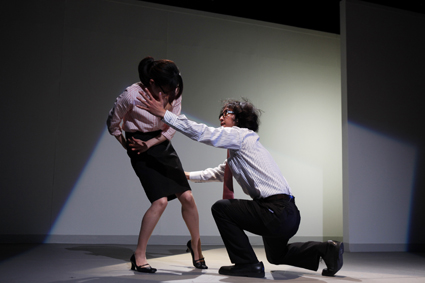
Hot Pepper, Chelfitsch
photo Toru Yokota
Hot Pepper, Chelfitsch
And yet the 1960s resistance to the cheaper sentiments of commercial theatre remains a guiding principle for much of the work at PuSh, as does the mistrust of dramatic peaks and valleys. The typical show tends to be kept within a narrow dynamic range (not too high, not too low), and performers tend to avoid over-expressing. This is certainly true of the mesmerising Hot Pepper, Air Conditioner, and Farewell Speech by Chelfitsch (Tokyo), in which choreographed movement based on everyday gesture is stretched to the edges of plausibility, but vocal and facial expression is restricted by office etiquette.
rabih mroué
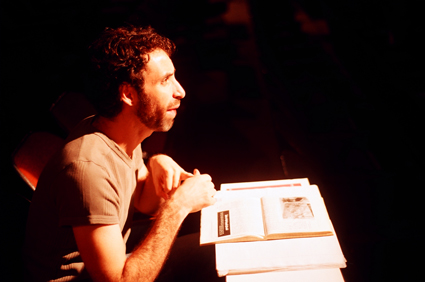
Rabih Mroué, Looking for a Missing Employee
photo Houssam Mchaiemch
Rabih Mroué, Looking for a Missing Employee
Rabih Mroué (Beirut), writer and director of Looking for a Missing Employee, adopts a Colombo-like faux naiveté while sifting through news documents that point to government collusion in the murder of a Finance Ministry worker. “Never trust a photocopy,” he says coyly while rifling through his own copies of articles from Lebanese dailies. Mroué renders even himself a copy by performing from behind the audience where a video camera projects his live image to a screen onstage. With such displacements, and with sly wit, Mroué gestures toward the guilty but never commits the aesthetic crime of shouting “Murderers!”
peter reder
Seduction of the spectator through understated personal charm is also a feature of Guided Tour by Peter Reder (London, England). This mock tour of the Vancouver Art Gallery has a thematic thread related to Walter Benjamin’s concept of “the angel of history”—a figure unable to repair the disasters of the past because it is being pushed relentlessly into the future by the fierce winds of paradise. Reder connects this concept to nostalgic constructions of our individual pasts. He provides a slideshow of family picnics at the beach, which might be from his childhood but—due to the generic quality of the images—could just as easily be from someone else’s. Like the angel of history, you can only reconstruct the past in your mind. In the meantime disasters will pile up. The success of this show ultimately depends on the rapport Reder establishes, through deft irony, with the small group of patrons he guides through the building. There are no startling revelations. Discoveries are kept in proportion. High drama is rejected in favour of intimate personal contact.
teatro linea de sombra
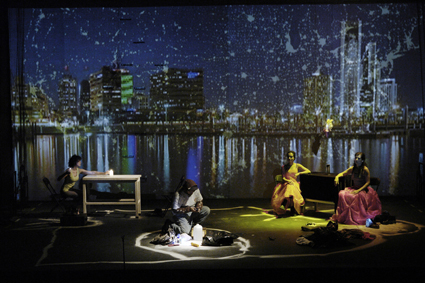
Amarillo, Teatro Linea de Sombra
photo Roberto Blenda
Amarillo, Teatro Linea de Sombra
Amarillo by Teatro Linea de Sombra (Mexico City) constructs the “probable” journey of a Mexican migrant worker who attempts a crossing into the USA. It begins with the packing of a desert survival kit that includes lemons for dehydration and painkillers for dealing with an 80-kilometre trek in 50 degree heat. It ends with death by drowning in a sea of sand. An upstage wall stands for the barrier between South and North. It is leaped at, climbed and pounded in vain by a man who will ultimately disappear. It also serves as a projection screen for the many surveillance quality cameras that shoot the action from above. Objects accumulate on the floor of the stage, and by the end we are looking through columns of sand, pouring down from above, at a projection of jugs full of blue water lit up by flashlights, as if a well-ordered and sentient constellation is trying to make sense of the dead man lying half-buried on the desert floor.
mario pensotti
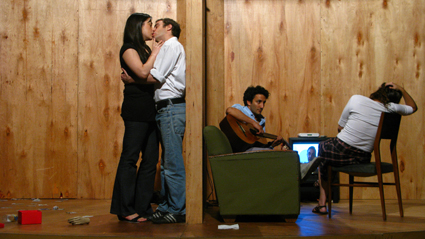
El Pasado, Mario Pensotti
photo Matias Sendon
El Pasado, Mario Pensotti
The action in El pasado es un animal grotesco by Mario Pensotti (Buenos Aires) keeps pace with the revolving stage on which interweaving stories of a number of 20-something urban Argentinians take place. The revolve itself is a beautiful plywood-clad thing, with rollers visible, and with scenic furniture stripped down to the bare living essentials. The characters that inhabit it are young and can’t afford to complete the furnishings—they are unfinished projects. Each is, in her or his own way, struggling to find a place in a globalised society in which individuals tend to be atomised worker/consumer units and personal connections are hard to sustain. Most of what happens to the characters seems accidental. As an actor exits a scene passing to the back of the revolve, she enters into and narrates another coming into view. The true narrative engine of the evening is the revolve, which is divided into quarters and is in almost continual motion throughout the performance. As a result the stories have a sense of forward momentum even though they unfold rather slowly. Like Benjamin’s angel, the characters can never go back, but neither are they propelled by a storm. Rather, they are continually nudged forward. Gentle as the push may be, the imperative of linear time is no less inexorable.
neworld/vancouver moving theatre
You might expect Fyodor Dostoyevsky’s The Idiot (Neworld/Vancouver Moving Theatre, Vancouver) to provide an old-school dramatic spike to those hungry for emotional punch. Seven years ago director James Fagan Tait (who also writes the adaptation) gave us the apotheosis of Crime and Punishment. The Idiot is a different kind of novel, slightly Chekhovian in the way character pretensions are consistently deflated. Tait’s Idiot is alternately ironic, sincere and down-to-earth, if a little liberal with the ‘F’ bombs. As with Crime we have the large, ethnically diverse cast made up of trained and un-trained actors, the spare staging, the beautiful group tableaux in which performers deliberately look like here-and-now Vancouverites in there-and-then attire, and the same quiet, unforced delivery that makes the spectator lean forward to catch every word. In keeping with much of the festival, performer expressivity is constrained. Even when Rogozhin (Andrew McNee) suffers a remorseful vocal utterance after murdering his lover Nastassia (Cherise Clarke), the momentary rupture is limited to a single, measured cry.
yes to seduction
There were a few shows at the festival that embraced melodrama, mid-20th century realism, or plain old kitsch. For me, these productions simply affirmed the value of the dominant aesthetic of the festival: don’t spoon-feed the audience. Of course, one can get over-cautious. In her 1965 manifesto Yvonne Rainer stridently demands, “No to moving and being moved.” Seriously? I want my money back. In 2008 she grudgingly acknowledges that “moving and being moved” is “unavoidable.” How terribly pinched. Andrea Božić counters, “Yes to transparency,” “Yes to enthusiasm,” “Yes to staying here.” I confess I go to performances hoping to be seduced. If you’ll indulge the allusion, seduction is acceptable as long as it occurs between mature, consenting spectators. The structure of the theatrical event provides the necessary “safe word.”
art, actually
And then there’s the fact of Norman Armour’s cardiac arrest. John Cage would have appreciated the circumstances: a chance “operation” occurring within the aesthetic frame of the festival. Parameters are established, and then what happens within them is “art.” Or is the heart attack too great a disturbance? Is it too real for art? Is it the aesthetic ‘body’ of the festival that is “in trouble,” as Mary Margaret O’Hara sings in her song? Probably not. Michael Boucher, the man who saved Armour, described the festival director’s collapse as “almost” comical. Ah, so it wasn’t tragedy, it was slapstick. Like the characters in The Idiot, we are rather impotent creatures. Our sufferings are real, but what does it all add up to? With Božić we must say, “Yes to confusion of the spectator”—ourselves. How can we authentically say otherwise? At the same time, in our relief at the survival of a fellow spectator, we can also say with Božić—and with Norman Armour—“Yes to staying here.” For as long as we can bear it.
2012 PuSh International Festival of Performing Arts, Vancouver, Jan 17-Feb 4; http://pushfestival.ca
RealTime issue #108 April-May 2012 pg. 12-13






